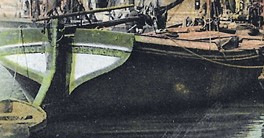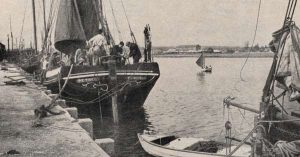Once, a Cement Works existed in Waldringfield and it had a fleet ofsailing barges. What became of them?
Masons Cement Works
A lime kiln or Roman Cement works (not from the Roman era, just a type of cement) stood on the site at Waldringfield Quay from the 1860s. Possibly the raw material, Septaria, came from the adjacent cliff, or Rocks or Cobbolds Point in Felixstowe.
In the early 1870s, Masons, owners of St. Peter’s Oil Mill and a timber business in Ipswich, established a Portland Cement Works on the quay at Waldringfield. This was a time of transition between Roman and the new Portland Cement.
The works remained at the quay until being demolished in 1907 when Masons moved to Claydon (the ‘clay’ is a clue as to why). The visitor may find it difficult to imagine that the works once stood there and would have bene appalled to see the flames and smoke that it generated. This, of course, would, according to wind direction, envelop the village and beach; not such a nice place to visit then. The river pollution from the washmill would, of course, be another unpleasant feature.
For those curious to see a comparison between the Cement Works and now, look at this Comparison of the Site from 1890s to 2000s.


Coincidentally, apart from the link above to Cobbold’s Point, part of the Cobbold family lived in the Maltings next to the works. Later on, Frank Mason1Frank Mason shared his name with an artist who painted sailing barges, this caused some confusion for a while., the owner, was to have a house (called Northcliff) near Cobbold’s Point in Felixstowe from where he could watch his barges, identifying them by the ‘Moon’ topmark.
Masons’ Portland Cement
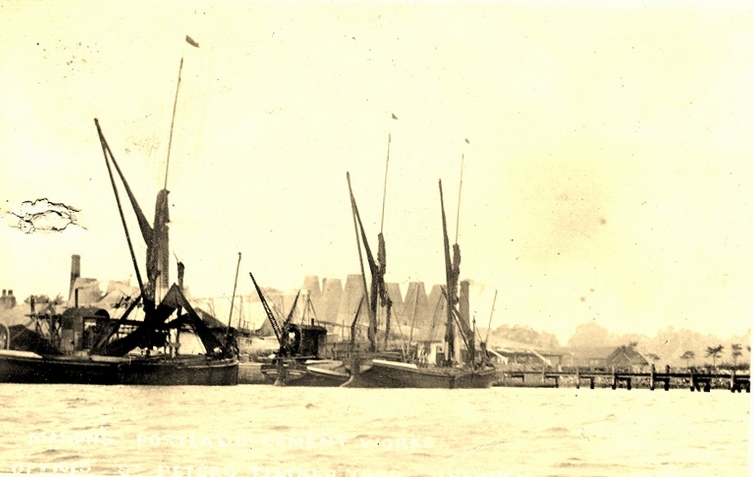
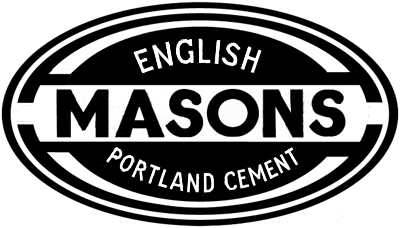
The product was shipped in casks, barrels, and jute sacks2,In a 1987 EADT article by Kenneth Mason, Frank Mason’s son, he says paper sacks made at Masons Paper Factory. Another source says paper was not used until after 1930. He was probably referring to practice at the Claydon works.. Five hundred barrels make a cargo of about ninety to a hundred tons3Casks, sacks, bags – Cement, Mud and Muddies, a history of APCM barges by F.G.Willmott. A barrel weighed 24lbs and carried 404lbs cement for export. Cement was delivered for the building of Southampton docks, and in 1898, sixty-three cargoes of cement left from Waldringfield of which fifty-one were carried in the firm’s barges: that’s about one each per month so there were some long trips. Over a year that requires about 32,000 barrels and where they came from is unclear. If they were brought in, then unless they were flat packed, that makes as many barge loads as there were for the finished product. They may have arrived in pieces for re-assembly or been made locally. Since Masons had an Ipswich timber business in their empire, it could be that barrels were made there4Barrels or casks – there is a record of a Cowper in Barrack Row, Sandy Lane so there may be a connection, a question to be staved off for another day..
This postcard was a receipt for fifty-one returned bags, and had been pre-printed for such a purpose in the days when a stamp cost a halfpenny: the card was delivered the next day. That they were returned suggests that the bags were not paper, but jute.
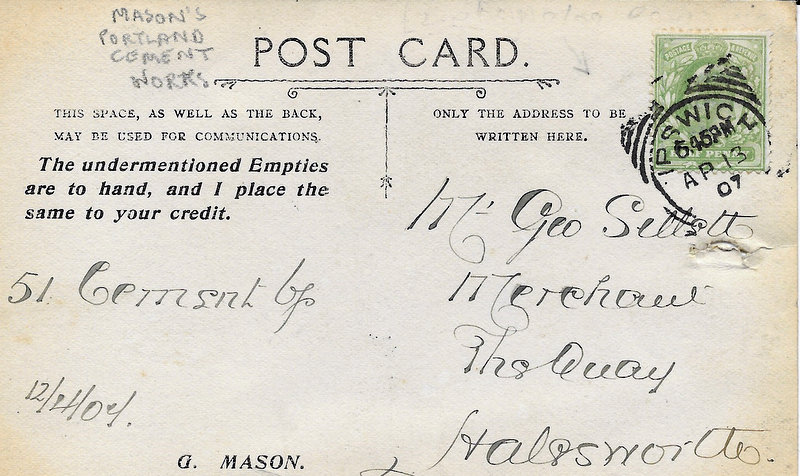
It was a revelation to learn that the address on the card, in Halesworth, was navigable, via Southwold, until 1883 (see Navigation to Halesworth). The date on the card was 1907 so this cargo went by road. Oh, how much we’ve lost.
Masons’ Fleet
Masons’ businesses depended upon water transport, consequently, they opened a shipyard at Stoke, Ipswich in 1874 and built the barges SB Augusta and Grace. The first was named after George Mason’s daughter Augusta and the second after Grace Eliza.
Frank Mason ordered Elsie Bertha in 1884 from the Kent barge builder Miltons, named for his daughter who died aged five months. Petrel was built by Orvis in Ipswich eight years later, but why didn’t she get a family-related name as well? Excelsior and Orinoco were bought second-hand. As Elsie Bertha was lost in 1894 it is probable that the Orinoco was her replacement. There were also Jumbo, and the Kingfisher which was used in mud digging. The eight known Masons’ barges can be considered to be Waldringfield’s ‘Home Fleet’.
With no rail and poor road connections, sailing barges were vital to supplying raw materials and transporting the finished cement. Lime or chalk came from the Medway. Coke breeze was shipped from the Deptford Gasworks on the Thames. Coke is light, so was shipped with hatches on end, and the mainsail raised a few feet to increase space5Hatches on end – Willmott, F.G. (n.d.) Cement, Mud and Muddies, a history of APCM barges. The only local commodity apart from labour was mud, which was taken from saltmarshes downriver.
These barges did not just carry cement; mixed cargoes of casks of oil and cement were carried to London. Return cargoes from the London River were carried for Cranfields of Ipswich who later purchased most of the Masons’ fleet. There must also have been cargoes of clinker from, most likely, the London River, and chalk or lime from the Medway.
Masons continued production at Claydon, west of Ipswich. Eventually, the plant was incorporated into APCM/Blue Circle6APCM/Blue CircleHistory of Cement Works.
Fates of the Barges
The factory closed in 1907, sometime around then Turner and Haste’s Freston Tower7Freston Tower – Smith, – Richard W & Freestone, J. (n.d.) The Port of Ipswich, it is Shipping and Trades. took the last 110 tons of Cement from the works.
Of the eight barges that were known to have been in the Masons fleet four sank, two were abandoned and the final fates of Jumbo and Kingfisher are unknown. Of those sunk, Orinoco was re-floated to sail again. The works site is now occupied by houses and the Boatyard. From 1907, the fleet may have traded under the Masons name but by 1912, all except Kingfisher, had been sold to Cranfields of Ipswich.
- Augusta was lost in a collision near the Nore light vessel with SS Hartington in 1902.
- Elsie Bertha was run down and sunk in the Swin; date unknown.
- Excelsior was hit by an incendiary bomb in 1940 in Ipswich, towed away from other vessels and left to sink by the lock gates in Ipswich where the remains are still visible at low water, although not to be confused with the nearby lifting barge wreck to the south. Work at the site from the late 2010s may have destroyed the wreck.
- Grace was abandoned as a hulk at Gravesend 1938 but is depicted in a postcard from around 1909 by which time she may have been with Cranfields.
- Jumbo may have been No. 85141 of the Cotton Powder Co. of London in 1916 but this is uncertain. In World War Two Jumbo was employed as a “Degaussing Mobile Wiping Unit” at Harwich in 1942, at which time she would have been sixty years old. Her partner was Torchbearer, earlier known as Bluebell. Degaussing was applied to reduce ships’ magnetic signatures and vulnerability to mines during the conflict.8Degaussing – www.harwichanddovercourt.co.uk
- Kingfisher, a motor yacht at Chelsea Dock in the early 1950s, but unknown after that.
- The only surviving Masons’ Cement barge is the Orinoco at Iron Quay Faversham. She was run down in the Thames and sunk in 1966 but has been re-floated and then restored by Laurie Tester. Geoff, ‘Frog’, Ingle now owns and races this 128-year-old vessel. (2023)
- Petrel – Became a housebarge at Battlesbridge in 1960 but was destroyed by fire in 1976 at Hoo in Kent.
Mason’s Crews
Shipping movement records show Jumbo with Brooks as the master in London in August 1888 and Quantrill in 1900. In the same year, we have Quantrill with Excelsior and Catchpole with Elsie Bertha. Strange appears as the master of Orinoco and Menter of Augusta in 1900. The Menters were related to Jack Stebbings of the smaller Kingfisher. Quantrill has Petrel in 1905. Catchpole has Excelsior in 1907 and Petrel in 1908 by which time Quantrill has the Orinoco. It looks as if they swapped around which makes sense. Masons’ known barge masters over a span of about twenty-five years were Brooks, Catchpole, Frost, Menter, Norman, Quantrill, Ruffles, Strange and Stebbings. Details of some are given with the barges they sailed. The Waldringfield History Group has more information on this topic.

Masons topmark and bob discussion
According to Walter Tye, who in the 1950s, spoke to people who remembered the period:
‘The moon on the topsails of the barges operating from Masons Works at Waldringfield ….” and “Frank Mason had his own fleet of barges, easily distinguished by a Moon in the topsail.’ – Walter Tye9W Tye (1956) A guide to Waldringfield and district.
The photograph of Elsie Bertha partly, but inconclusively, shows the top mark, or emblem. Masons’ barges went to Cranfields of Ipswich. In ‘Spritsail’, Richard Hugh Perks10Richard Hugh Perks- “The Port of Ipswich, Its Shipping and Trades states that Cranfields’ White Circle came from Masons and they had no fleet prior to 1912. This strongly suggests that the Masons’ topmark was a white disc.
We do not have useful photographs of these barges with sails raised, due to the long camera exposures required at that time and the lack of cameras.
It has also been said that Masons or Cranfields mark was known as the ‘Plum Duff’ but that implies a semi-circle to pudding lovers.
It seems odd that a white circle would be described as a Moon shape. There was a crescent moon top mark belonging to L.R.T. Co. of Kent (a later company) which clearly would be referred to as such. The reach just upriver from the Cement Works was marked on the 1845 Admiralty survey as ‘Half Moon Reach’. It is fanciful to imagine, although unlikely, that this was adopted by Masons when they started their fleet by building Augusta and Grace in 1874 at their Ipswich yard. However, were this the case why would Cranfields have changed it?
Cranfields also had a bob (the topmast burgee) with a “C” in a serrated circle. We know from photographs that Masons’ also had a bob but, sadly, do not know what it was.
Other barges
Barges not owned by Masons also served the Cement Works. The Ocean Queen, Three Sisters, Frederick William and Lady of the Wave were among them11 Barges not owned by Mason’s – Smith, – Richard W & Freestone, J. (n.d.) The Port of Ipswich, it is Shipping and Trades. . The Woodbridge schooner Bernard Barton also transported cement, but a deep draught vessel would not be well suited to work on the Deben. Robert Simper mentions the steamer Winifred carrying cement to the north12Steamer Winifred – the only likely vessel found is Winifred built 1898 although she had a 20 ft. draught. See Simper, R. (1972) Woodbridge and Beyond. First Edition edition. Ipswich, East Anglian Magazine.. Bluebell‘s remains are in St. Osyth Creek.
Masons’ Barges and their activities.
From Deptford to the Deben by barge
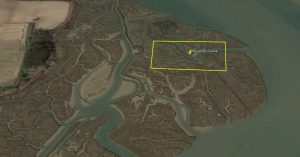
Mud Digging at Hemley for the Cement Works
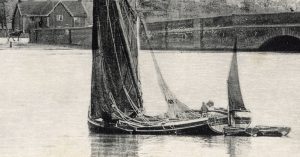
SB Augusta
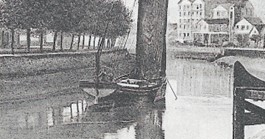
SB Elsie Bertha
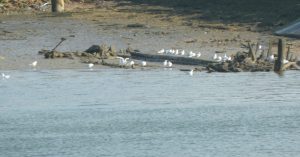
SB Excelsior
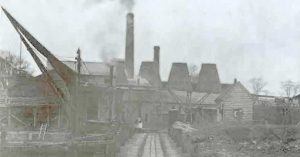
SB Kingfisher
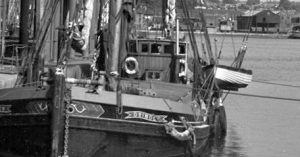
SB Orinoco
Notes on Crews and Movements
Crews
Masters and mates were highly skilled seamen and must have been fit and strong. Unlike today’s leisure sailors, they worked the year through in all weather without the benefit of modern equipment and foul weather gear. The Mustos, Dubarry boots and smartphones with GPS charts of the typical yachtie would have been beyond their wildest dreams. Their usual clothing was a cheese cutter cap and blue jersey, and some wore tarred bowler hats. A good example of this is shown in the ‘Muck and Straw’ photograph.
Some, but not all of the sailors, were Waldringfield men like Jack Stebbings. Ben Page and others lived nearby. Jimmy Quantrill was later the publican. Another publican, Isaac Stollery, operated a ferry service to the opposite shore as there was not a sufficient population in the village to supply the required workforce for farms, the Maltings, the Cement Works and coprolite mining.
Jimmy Quantrill was the skipper of Excelsior in 1914 for Cranfields. One voyage was in Azarias to Dunkirk to collect ‘Eye powder’; this was Galena or white lead used by industry in Ipswich. Azarias was later swamped at anchor in the Whitaker in the winter of 1940/41 and lost together with her crew. He, or possibly another of the many Quantrills in the trade, was with Cranfields’ Orinoco by 1944.
Arthur Catchpole, another smartly dressed man, had Masons’ Elsie Bertha when she was run down and sunk in the Swin, and, later, Masons’ Petrel. He wore a felt hat, white collar and cuffs, and was known as ‘Skatty”’
Other names were Brooks of Elsie Bertha, Hardun and Norman as well as two pilots, probably Woodbridge men, Nelson Oxborrow and Ted Marsh who worked from Waldringfield. Robert Simper still has Sam Marsh’s pilot boat ‘Teddy‘. There were, in Victorian times, around six pilots taking barges and schooners up to Woodbridge. The Teddy is the only one of their fast/rowing sailing boats to survive.
Known Movements
| Year | Vessel | Skipper | Mate | Notes |
| 1894 | Augusta | Strange | ||
| 1898 | Augusta | Brooks | Smith | In Harwich Race |
| 1900 | Augusta | Menter | ||
| 1902 | Augusta | Sunk | ||
| 1894 | Elsie Bertha | Brooks | ||
| 1900 | Elsie Bertha | Catchpole | ||
| 1915 | Elsie Bertha | Catchpole | Cranfields 1915 later sunk | |
| 1900 | Excelsior | Quantrill | ||
| 1907 | Excelsior | Catchpole | ||
| 1914 | Excelsior | Quantrill | ||
| 1941 | Excelsior | Sunk | ||
| 1894 | Grace | Strange | ||
| 1938 | Grace | Hulked | ||
| 1888 | Jumbo | Brooks | ||
| 1900 | Jumbo | Quantrill | ||
| 1881 | Kingfisher | Frost | Page | Census record. Stebbings later skipper. |
| 1897 | Orinoco | Ruffles | ||
| 1900 | Orinoco | Strange | ||
| 1908 | Orinoco | Quantrill | ||
| 1914 | Orinoco | Ruffles | ||
| 1897 | Petrel | In Harwich Race | ||
| 1905 | Petrel | Quantrill | ||
| 1908 | Petrel | Catchpole | ||
| 1914 | Petrel | Catchpole | ||
| 1914 | Petrel | Norman | ||
| 1894 | Grace | Quantrill | ||
| 1894 | Grace | Woodcock | ||
Questions
The design of the Bob has not been found.
Fate of Jumbo.
Sources
The History of the works was covered in the River Deben Magazine in 2011 and updated in the Waldringfield History Group book.
For more on Cement Works see Cement Kilns: Waldringfield which has an very detailed history.
Cranfield’s fleet – Smith, – Richard W., and Jill Freestone. The Port of Ipswich, Its Shipping and Trades.
Thanks to A.Videlo and M.Lake for crew and movement data.
Footnotes
- 1Frank Mason shared his name with an artist who painted sailing barges, this caused some confusion for a while.
- 2,In a 1987 EADT article by Kenneth Mason, Frank Mason’s son, he says paper sacks made at Masons Paper Factory. Another source says paper was not used until after 1930. He was probably referring to practice at the Claydon works.
- 3Casks, sacks, bags – Cement, Mud and Muddies, a history of APCM barges by F.G.Willmott. A barrel weighed 24lbs and carried 404lbs cement for export
- 4Barrels or casks – there is a record of a Cowper in Barrack Row, Sandy Lane so there may be a connection, a question to be staved off for another day.
- 5Hatches on end – Willmott, F.G. (n.d.) Cement, Mud and Muddies, a history of APCM barges
- 6APCM/Blue CircleHistory of Cement Works
- 7Freston Tower – Smith, – Richard W & Freestone, J. (n.d.) The Port of Ipswich, it is Shipping and Trades.
- 8Degaussing – www.harwichanddovercourt.co.uk
- 9W Tye (1956) A guide to Waldringfield and district.
- 10Richard Hugh Perks- “The Port of Ipswich, Its Shipping and Trades
- 11Barges not owned by Mason’s – Smith, – Richard W & Freestone, J. (n.d.) The Port of Ipswich, it is Shipping and Trades.
- 12Steamer Winifred – the only likely vessel found is Winifred built 1898 although she had a 20 ft. draught. See Simper, R. (1972) Woodbridge and Beyond. First Edition edition. Ipswich, East Anglian Magazine.
Image Sources and Credits
Image Credits and Sources
- Mason’s cement works Waldringfield: Mason's cement works Waldringfield Quay Courtesy Ron Green
- masons_logo-: cementkilns.co.uk
- Reverse-of-Mason-postcard-as-receipt-Courtesy-Ron-Green: Reverse of Mason postcard as receipt Courtesy Ron Green
- 1Frank Mason shared his name with an artist who painted sailing barges, this caused some confusion for a while.
- 2,In a 1987 EADT article by Kenneth Mason, Frank Mason’s son, he says paper sacks made at Masons Paper Factory. Another source says paper was not used until after 1930. He was probably referring to practice at the Claydon works.
- 3Casks, sacks, bags – Cement, Mud and Muddies, a history of APCM barges by F.G.Willmott. A barrel weighed 24lbs and carried 404lbs cement for export
- 4Barrels or casks – there is a record of a Cowper in Barrack Row, Sandy Lane so there may be a connection, a question to be staved off for another day.
- 5Hatches on end – Willmott, F.G. (n.d.) Cement, Mud and Muddies, a history of APCM barges
- 6APCM/Blue CircleHistory of Cement Works
- 7Freston Tower – Smith, – Richard W & Freestone, J. (n.d.) The Port of Ipswich, it is Shipping and Trades.
- 8Degaussing – www.harwichanddovercourt.co.uk
- 9W Tye (1956) A guide to Waldringfield and district.
- 10Richard Hugh Perks- “The Port of Ipswich, Its Shipping and Trades
- 11Barges not owned by Mason’s – Smith, – Richard W & Freestone, J. (n.d.) The Port of Ipswich, it is Shipping and Trades.
- 12Steamer Winifred – the only likely vessel found is Winifred built 1898 although she had a 20 ft. draught. See Simper, R. (1972) Woodbridge and Beyond. First Edition edition. Ipswich, East Anglian Magazine.
Image Credits and Sources
- Mason’s cement works Waldringfield: Mason's cement works Waldringfield Quay Courtesy Ron Green
- masons_logo-: cementkilns.co.uk
- Reverse-of-Mason-postcard-as-receipt-Courtesy-Ron-Green: Reverse of Mason postcard as receipt Courtesy Ron Green
